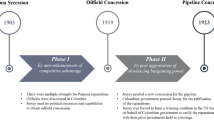Abstract
Abel Ferrara’s 1990 film King of New York, and specifically the film’s transgressive use of The Plaza Hotel, presents a unique way to see the restructuring of the social and economic order via Pierre Bourdieu’s field theory. Contextualizing the New York City landscape as a personification of a capitalist social and economic order from which its characters have literally and metaphorically profited turns King of New York in a cinematic space where differing fields ‘battle’ for the ultimate prize of control over these fields. With this in mind, we can see through Pierre Bourdieu’s field theory how Ferrara reinscribes the relationship between space, social organization, and capitalist economics within the cinematic spaces of the film.




Similar content being viewed by others
Notes
All times, chapters and quotes come from the King of New York: Special Edition released by Artisan in 2004.
References
Bourdieu, P. (1977). Outline of a theory of practice. Polity Press.
Bourdieu, P. (1984). Distinction: A social critique of the judgment of taste. Routledge.
Bourdieu, P. (1986). The forms of capital. In J. G. Richardson (Ed.), Handbook of theory and research for the sociology of education. Greenwood.
Bourdieu, P. (1990). The logic of practice. Stanford University Press.
Bourdieu, P. (1998). Acts of resistance. Polity Press.
Bourdieu, P. (2000). Pascalian meditations. Polity Press.
Bourdieu, P., & Wacquant, L. (1992). An invitation to reflexive sociology. Polity Press.
Clarke, D. B. (Ed.). (1997). The cinematic city. Routledge.
Clarke, D. B., Phannhauser, V., & Doel, M. (Eds.). (2009). Moving pictures/stopping places: Hotels and motels on film. Lexington Books.
Donald, J. (1999). Imagining the modern city. University of Minnesota Press.
Dovey, K. (2005). The silent complicity of architecture. In J. Hillier & E. Rooksby (Eds.), Habitus: A sense of place. Ashgate Publishing Co.
Harvey, D. (1996). Justice, nature and the geography of difference. Blackwell Publishers.
Hesmondhalgh, D. (2006). Bourdieu, the media and cultural production. Media, Culture & Society, 28(2), 211–231.
Hillier, J., & Rooksby, E. (2005). Habitus: A sense of place (2nd ed.). Ashgate Publishing.
Hopkins, J. (1994). A mapping of cinematic places: Icons, ideology and the power of (Mis) representation. In S. Aitken & L. E. Zonn (Eds.), Place, power, situation, and spectacle. Rowman and Littlefield.
Ilan, J. (2013). Street social capital in the liquid city. Ethnography, 14(1), 3–24.
Little, K. (1995). Surveilling cirque archaos: Transgression and the spaces of power in popular entertainment. Journal of Popular Culture, 29(1), 15–28.
McCarthy, B., & Hagan, J. (2001). When crime pays: Capital, competence, and criminal success. Social Forces, 79(3), 1035–1059.
Morris, M. (1992). Great moments in social climbing: King Kong and the human fly. In B. Colomina (Ed.), Sexuality and space. Princeton Archetectural Press.
Painter, J. (2002). Pierre Bourdieu. In M. Crang & N. Thrift (Eds.), Thinking space. Routledge.
Pike, B. (1981). The city as image. In R. LeGate & F. Stout (Eds.), The city reader. Routledge.
Pile, S. (1995). The body and the city: Psychoanalysis, space and subjectivity. Routledge.
Pile, S., & Thrift, N. (1995). Introduction. In S. Pile & N. Thrift (Eds.), Mapping the subject: Geographies of cultural transformation. Routledge.
Sandberg, S. (2008). Street capital: Ethnicity and violence on the streets of Oslo. Theoretical Criminology, 12(2), 153–171.
Schubert, J. (1995). From a politics of transgression toward an ethics of reflexivity. American Behavioral Scientist, 38(7), 1003–1017.
Shammas, V., & Sandberg, S. (2016). Habitus, capital, and conflict: Bringing bourdieusian field theory to criminology. Criminology and Criminal Justice, 16(2), 195–213.
Thompson, J. (1991). Introduction. In Pierre Bourdieu (Ed.), Language and symbolic power. Polity Press.
Author information
Authors and Affiliations
Corresponding author
Ethics declarations
Conflict of interest
There is no conflict of interest with regard to this essay, authorship or research represented therein.
Ethical approval
The authors of the paper “‘‘Conflicting Fields: A Bourdieuian Guide to The King of New York” have complied with ethical standards of research under the guidance of California State University, Northridge.
Research involving human and animal participants
No research involved human participation.
Additional information
Publisher's Note
Springer Nature remains neutral with regard to jurisdictional claims in published maps and institutional affiliations.
Rights and permissions
About this article
Cite this article
Craine, J. Conflicting fields: a Bourdieuian guide to The King of New York. GeoJournal 87 (Suppl 1), 105–114 (2022). https://doi.org/10.1007/s10708-022-10647-y
Accepted:
Published:
Issue Date:
DOI: https://doi.org/10.1007/s10708-022-10647-y




